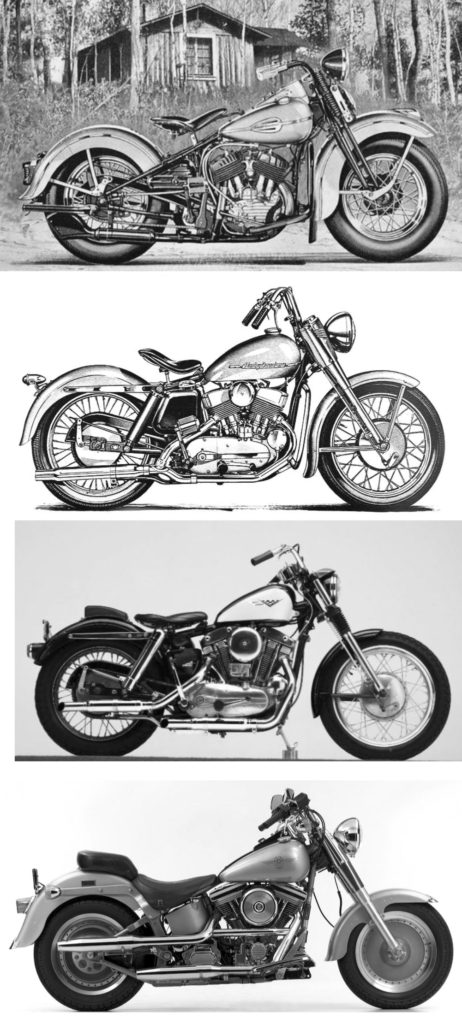Harley Davidson 45WL, Models K, XLCH, Fat Boy, XR-750
Most bikers have heard the story that William Harley and Arthur Davidson were bicycle makers who started the Harley Davidson Motor Company in a 10 foot by 15 foot shack in Milwaukee Wisconsin. That’s a rather gross over simplification which isn’t particularly accurate.
Harley and Davidson grew up as neighbors, who as teenagers, loved tinkering with various mechanical projects. At 15, Harley went to work for a bicycle manufacturer, Meiselbach Mfg. Company, while Davidson got a job at Barth Mfg. Company, a metal fabrication Shop. Harley eventually joined Davidson at Barth.
Together with Davidson’s mechanic brother, Walter, they came up with their first motorcycle in 1903. Harley went to college to study engineering, graduating in 1907. There he came up with the idea of the V-twin motorcycle engineering. The rest is history.
The Harley Davidson 45WL was introduced in 1937, as successor to the earlier Model R. It was a 45 cubic inch flathead V-twin, rigid frame design with springer front forks. HD used a letter designation to identify the variants of a particular model. The early Model W was the basic model, with the WL having slightly higher compression. The WLA was the Army model, and the WLC being the Canadian Army model.
The Model 45 was produced for many years, being replaced in 1952 by the Model K. The engine continued to be produced through 1973 to power the 3 wheel Servi-Car.
The Model K was introduced in 1952 in an effort to better compete with the lightweight British motorcycles, which were extremely popular in the U.S. at the time. The 45 cubic inch flathead K was a unit construction bike with rear suspension, telescopic forks, and a profile more closely resembling the popular British bikes. The 1954 Model KH brought a displacement increase to 55 cubic inches and the Model KHK added big cams and polished ports.
The Model K offered a substantially more comfortable ride than previous Harleys, and paved the way for suspension improvements in the entire line. The Model K essentially became the 1957 Sportster, with the addition of an overhead valve configuration.
The 1957 XL Sportster was pretty much a revamped Model K with some frame changes to accommodate the taller overhead valve 55 cubic inch engine. In 1958, the XLH featured electric starting a buddy seat, and saddlebags. The XLCH was a hot rod model with kick starting only, hot cams, and a magneto ignition. It was the first Harley to be truly competitive, performance wise, with the British bikes. It also was the first Sportster to utilize the now famous, “peanut tank.”
The Harley Davidson Fat Boy was introduced in 1990. It’s hard to determine the styling features that made the bike attractive, but they obviously did the trick. The Fat Boy has solid disc wheels, wide-set front forks, a rather bulbous extra wide gas tank, and a belt drive. The wheels were undoubtedly the signature feature, despite the problems they posed during heavy cross-winds.
The Fat Boy used the Softail chassis, introduced in 1984, which hides the rear shocks under the gearbox, making the bike resemble the early rigid frame configuration. This set-up was used until 2017, when it was revamped to place a single shock absorber under the seat.
While the Fat Boy is not necessarily a “vintage” bike by some definitions, I have included it among the laser cut silhouettes due to its long-term popularity and a number of requests.
XR-750
The Harley Davidson XR-750 V-twin was the 1970 replacement for the KR-750 flat head racing motorcycle. The KR had enjoyed racing success prior to WWII, after which it became outmatched by British overhead valve (OHV) and overhead cam bikes.
The new XR-750 was powered by a de-stroked Sportster engine with a slightly bigger bore. This brought the displacement to just under the 750cc maximum allowed by the AMA racing rules.
The Sportster heads developed overheating problems, so new ported and polished aluminum alloy heads replaced them. The XR-750 used separate Mikuni carburetors for each cylinder, with a pair of upswept exhaust pipes. While Harley was distressed by the need to abandon their old flathead bike, the new combination proved to be a World-beater. The bike had 82 h.p. with gearing that produced a 115 mph top speed.
In 1983, Harley came out with a street legal 1,000cc version of the bike, but at nearly double the price of a regular Sportster, buyer response was lukewarm. It was dropped in 1985. A 1,200cc 90 h.p. model replaced it, but was more of a restyled Sportster than an XR-750 look-alike. It was discontinued in 2017.
In addition to winning races, the Harley Davidson XR-750 was popular among stunt riders. Evel Knievel was probably the best known of these stuntmen and jumped 137 feet over 14 buses in 1975.

